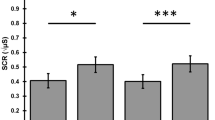Abstract
The orienting response (OR) is a specific behavioral act directed towards extraction of information from the environment. Head and eye movements represent only the tip of the iceberg of internal responses, which includes vascular modifications, EEG changes, and event-related potentials. Two mechanisms of the OR have to be differentiated: voluntary and involuntary. In the event-related potential, such a differentiation is expressed in mismatch negativity (involuntary effect) and processing negativity (voluntary effect). Single unit studies have shown that hippocampal neurones are simulating specific features of the OR as a response to novelty. Repeated presentation of stimuli results in a selective habituation of novelty detectors in hippocampus and of the OR. The trace of a standard stimulus formed at the level of hippocampal neurones matches the features of the standard stimulus and can be called a “neuronal model of the stimulus.” The OR is triggered by mismatch between the test stimulus and the elaborated neuronal model, and is activated by verbal instruction, by reinforcement during the initial stage of conditioned reflex elaboration, and by differentiation of signal and non-signal stimuli.
A promising new area of practical application of the OR lies in the evaluation of a corridor of optimal functional state for efficient computer-based learning. Registration of the OR and defensive responses can be used for an objective evaluation of the functional state of the student, or, in a wider sense, of the industrial operator. New avenues of OR research are opened by recent techniques that isolate single-trial event related potentials, and their correlation with autonomic and behavioral manifestations of the OR. The combination of single unit recording with such isolated event related potentials can elucidate the neuronal basis of OR generation. Intracellular recording combined with dye injection can be used for analysis of the synaptic contacts involved in generation of the OR.
Integration of macro and micro levels of OR organization can be achieved in a computerized model that can be used for simulation and planning of experiments. A step-by-step improvement of the model will accumulate knowledge about the OR as an important mechanism of information processing.
Similar content being viewed by others
References
Horn, G. (1970) Changes in neuronal activity and their relationship to behaviour. In G. Horn and R. Hinde (Eds.),Changes in Neuronal Activity and Behaviour. Cambridge: Cambridge University Press, pp. 567–606.
Izmailov, C.A., Sokolov, E.N., and Chernorizov, A.M. (1989)Psikhofisiologiya tsvetovogo zreniya. (Psychophysiology of color vision.) Moskva: Isdatelstvo Moskovskogo Universiteta.
Jung, R. (1961) Neuronal integration in the visual cortex and its significance for visual information. In W. Rosenblith (Ed.),Sensory communication. Cambridge, Mass.: MIT Press., pp. 627–674.
Kenemans, J.L., Verbaten, M.N., Sjouw, W., and Slangen, J.L. (1988) Effects of task relevance on habituation of visual single-trial ERPs and the skin conductance orienting response.International Journal of Psychophysiology, 6, 51–63.
Näätänen, R. (1979) Orienting and evoked potentials. In H.D. Kimmel, E.H. van Olst, and J.F. Orlebeke (Eds.),The Orienting Reflex in Humans. Hillsdale, N.J.: Erlbaum, pp. 61–75
Näätänen, R. (1982) Processing negativity: An evokedpotential reflection of selective attention.Psychological Bulletin, 92, 605–640.
Näätänen, R., Sams, M., Alho, K., Paavilainen, P., Reinikainen, K., and Sokolov, E.N. (1988) Frequency and location specificity of the human vertex N1 wave.Electroencephalography and Clinical Neurophysiology, 69, 523–531.
Schiller, P.H. (1975) Single-unit recording and stimulation in superior colliculus of the alert monkey.Journal of Neurophysiology, 35, 915–924.
Sokolov, E.N. (1963)Perception and the Conditioned Reflex. Oxford: Pergamon Press.
Sokolov, E.N. (1969)Mekhanizmy pamyat. (Mechanisms of memory.) Moskva: Isdatelstvo Moskovskogo Universiteta.
Sokolov, E.N. (1986) Research strategy in psychophysiology. In R.B. Marcus, G.Y.W. Dorn, and P. Weingartner (Eds.),Logic, Methodology and Philosophy of Science, VII. Amsterdam: North-Holland, pp. 495–502.
Suga, N. (1964) Single unit activity in the cochlear nucleus and inferior colliculus of echo-locating bats.Journal of Physiology, 172, 449–474.
Vernier, V. and Galambos, R. (1957) Responses of single medial geniculate body units to repetitive click stimuli.American Journal of Physiology, 188, 233–237.
Author information
Authors and Affiliations
Rights and permissions
About this article
Cite this article
Sokolov, E.N. The orienting response, and future directions of its development. Pav. J. Biol. Sci. 25, 142–150 (1990). https://doi.org/10.1007/BF02974268
Issue Date:
DOI: https://doi.org/10.1007/BF02974268




